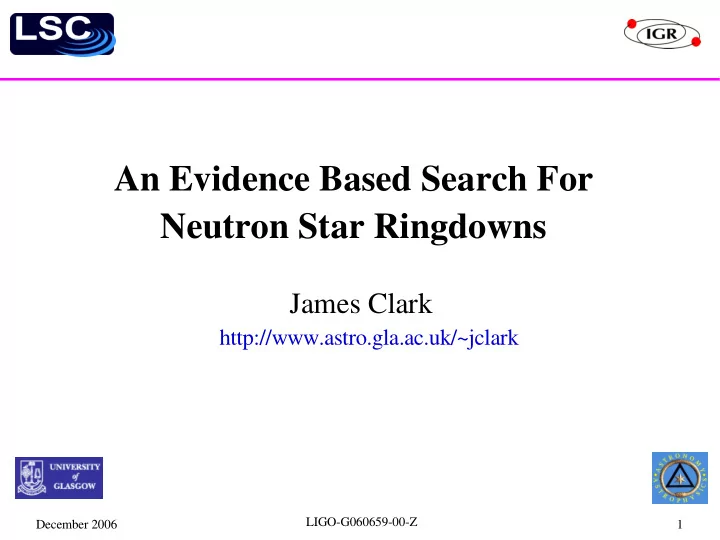

An Evidence Based Search For Neutron Star Ringdowns James Clark http://www.astro.gla.ac.uk/~jclark LIGO-G060659-00-Z December 2006 1
Overview Objective: Construct a (triggered) Bayesian search algorithm for neutron star ring-downs Neutron star ring-downs Bayesian model selection & evidence Application & analysis pipeline Preliminary sensitivity estimates Future work LIGO-G060659-00-Z December 2006 2
Neutron Star Ring-downs Possible GW emission from neutron stars via quasi-normal mode (QNM) oscillations. QNMs may be excited by (e.g.): Birth of neutron star in core-collapse supernova Soft gamma repeater (SGR) flares: − highly magnetised NS, B-field stresses induce crustal cracking & excite QNMs, leading to GWs − Trigger: GRB observations (e.g., SGR1806-20 – GEO & LHO data) Pulsar glitches − Spin-down (and or de-coupling of crust/core, internal phase transition) induces crustal cracking due to relaxation of ellipticity: starquake. − Trigger: pulsar timing data LIGO-G060659-00-Z December 2006 3
Neutron Star Ring-downs LIGO-G060659-00-Z December 2006 4
Bayesian Model Selection For competing models , compute the odds ratio (ratio of posteriors probabilities) : Odds ratio consists of 2 terms: prior odds Bayes factor is the evidence for the model (likelihood, marginalised over some model parameters and weighted by the prior) : LIGO-G060659-00-Z December 2006 5
Applying Model Selection Operation Outline : Data contains a ring-down in Gaussian white noise Likelihood function for a single datum , given an arbitrary signal power & Gaussian noise is a non-central chi-squared distribution with non- centrality parameter : where is modelled with a Lorentzian line profile, parameterised by : Data only contains Gaussian white noise Know a priori that the `signal power' is zero – use the same likelihood function with a strong prior on to get the central chi-squared distribution for the evidence LIGO-G060659-00-Z December 2006 6
Priors Choice of priors for Assume parameters are independent so that: LIGO-G060659-00-Z December 2006 7
Applying Model Selection Operation Outline Aim is to detect a known waveform in a stretch of noisy interferometer data with known properties: - probability that the data contains a ring- down waveform and white noise - probability that the data contains only white noise → Odds ratio acts like a detection statistic for ring-downs versus white noise LIGO-G060659-00-Z December 2006 8
Analysis Pipeline illustrative example spectrogram with ringdown: 1. Construct spectrogram centered on external trigger (e.g., pulsar glitch) 2. Compute all possible & likelihoods for pixels & marginalise to get evidences in each time bin 3. Assume no prior model bias and compute odds ratio: 4. 5. Finally, identify events with: LIGO-G060659-00-Z December 2006 9
Analysis Pipeline illustrative example spectrogram with ringdown: 1. Construct spectrogram centered on external trigger (e.g., pulsar glitch) 2. Compute all possible & likelihoods for pixels & marginalise to get evidences in each time bin 3. Assume no prior model bias and compute odds ratio: Finally, identify events with: LIGO-G060659-00-Z December 2006 10
Analysis Pipeline 1. Construct spectrogram centered on log odds from previous example: external trigger (e.g., pulsar glitch) 2. Compute all possible & likelihoods for pixels & marginalise to get evidences in each time bin 3. Assume no prior model bias and compute odds ratio: 4. 5. Finally, identify events with: LIGO-G060659-00-Z December 2006 11
An Example Compare response to target (ring-down - RD) waveform and an unwanted glitch (sine-Gaussian - SG) RD SG Inject 1 ring-down and 1 sine-Gaussian of roughly equal SNR into synthetic Gaussian white noise LIGO-G060659-00-Z December 2006 12
Example Output Output from odds algorithm: RD : ring-down is detected with odds well above that of background : sine-Gaussian is also detected SG In fact, for the sine-Gaussian: LIGO-G060659-00-Z December 2006 13
Example Output Solution - consider an alternative 'glitch' hypothesis : data contains a sine-Gaussian in Gaussian white noise SG RD LIGO-G060659-00-Z December 2006 14
Performance Estimate Receiver operating characteristics LIGO-G060659-00-Z December 2006 15
Future Plans Short-term: Finish writing up methodology (J. Clark et al. in preparation) Run code on GEO & LIGO data from around SGR1806-20 – need to know what happens with real data... (have data) Long-term: Upper limits on SGR1806-20 based on posterior probabilities and/or search sensitivity Look at other sources (pulsar glitches, GRB ring-downs) Potentially have a framework for multi-detector analysis from joint probabilities between detectors LIGO-G060659-00-Z December 2006 16
end LIGO-G060659-00-Z December 2006 17
Sensitivity Estimates LIGO-G060659-00-Z December 2006 18
Sensitivity Estimates LIGO-G060659-00-Z December 2006 19
Sensitivity Estimates LIGO-G060659-00-Z December 2006 20
Sensitivity Estimates LIGO-G060659-00-Z December 2006 21
Sensitivity Estimates LIGO-G060659-00-Z December 2006 22
Sensitivity Estimates Using original odds ratio, : LIGO-G060659-00-Z December 2006 23
Sensitivity Estimates Using original odds ratio, : LIGO-G060659-00-Z December 2006 24
Recommend
More recommend